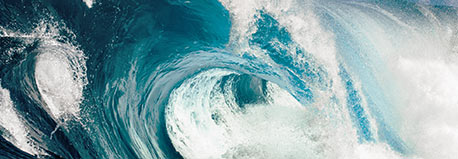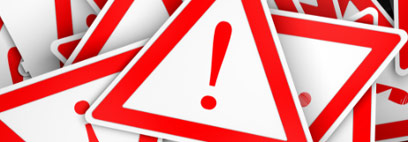What is a Tsunami?
A tsunami is a series of long waves caused by a large and sudden displacement of the ocean. The speed of a tsunami depends on the depth of the water it’s traveling through. The deeper the water, the faster the tsunami. In the deep ocean, tsunami move as fast as a jet plane. As they enter shallow water near land, they slow to 20 or 30 mph. As they slow down, tsunami grow in height. When they arrive on shore, most are less than 10 feet high. In some cases, they can be 100 feet in height.
News Release - California Geological Survey Issues New Tsunami Hazard Maps for SLO County
Tsunami Alert Levels
|
Tsunami Warning |
|
A Tsunami Warning is issued when a tsunami with the potential to generate widespread inundation is imminent, expected, or occurring. Warnings let you know that dangerous coastal flooding accompanied by powerful currents is possible and may continue for several hours after initial arrival. Warnings may be updated, adjusted geographically, downgraded, or canceled based on updated information and analysis. |
|
Tsunami Advisory |
|
A Tsunami Advisory is issued when a tsunami with the potential to generate strong currents or waves dangerous to those in or very near the water is imminent, expected, or occurring. The threat may continue for several hours after initial arrival, but significant inundation is not expected for areas under an Advisory. Advisories may be updated, adjusted geographically, upgraded to a warning, or canceled based on updated information and analysis. |
|
Tsunami Watch |
| A Tsunami Watch is issued when a tsunami may later impact the Watch area. The Watch may be upgraded to a Warning or Advisory or canceled based on updated information and analysis. |
|
Tsunami Information Statement |
| A Tsunami Information Statement is issued when an earthquake or tsunami has occurred of interest to the message recipients. In most cases, Information Statements are issued to indicate there is no threat of a destructive basin-wide tsunami and to prevent unnecessary evacuations. Information Statements for distant events requiring evaluation may be upgraded to a Warning, Advisory, or Watch based on updated information and analysis. |
Tsunami Information
|
Where do tsunami happen? |
|
Large tsunami can flood low-lying coastal areas more than a mile inland. Not all tsunami are the same, and a tsunami may act differently due to local and coastal geographical features. A small tsunami in one place may be very large and violent tsunami a few miles away. Tsunami can occur in all of the world’s oceans, inland seas, and in any large body of water. Certain areas are at high risk for tsunami. This is due to their location near local tsunami sources and exposure to distant tsunami sources. It is also due to the shape of the nearby seafloor and coastal geographic features. Low-lying areas such as beaches, bays, lagoons, harbors, and river mouths leading to the ocean are most at risk |
|
U.S. West Coast’s tsunami hazard level |
| The West Coast states of Washington, Oregon, and California have experienced tsunami from as far away as Alaska, South America, Japan, and Russia. The most damaging on record is the tsunami caused by the 1964 Great Alaska earthquake. More recently, harbors in the region were damaged by events in Japan (2011) and Chile (2010). Locally, the greatest threat is from the Cascadia subduction zone. |
|
Tsunami safety |
| Although tsunami cannot be prevented, there are things that can be done before, during, and after a tsunami that could save lives. |
|
What is my risk? |
| A tsunami can strike any coastline, but the threat is not the same everywhere. To better understand your risk, find out if your home, school, workplace, or other places you visit are in a tsunami hazard zone and if your community has had tsunami in the past. |
|
How will I know if a tsunami is coming? |
| There are two ways you might learn that a tsunami is coming: A Tsunami Warnings from local officials or a natural tsunami warning. Both are equally important. Be prepared to take action to whichever warning you receive first. |
|
Official tsunami warning |
| An official Tsunami Warning from local officials will likely be broadcast through local radio and television, NOAA Weather Radios, wireless emergency alerts, or marine radio. There may not always be time for an official Tsunami Warning to be issued, so it’s important to understand natural warning signs. |
|
Natural tsunami warnings |
| Natural tsunami warnings include a strong earthquake, a loud roar from the ocean, and strange ocean behavior. The ocean could look like a fast-rising flood, wall of water, or it could drain away suddenly. If you experience any of these natural warnings, a tsunami could be coming. A natural tsunami warning may be your first or only warning that a tsunami is coming. |
|
Preparing for a tsunami |
|
It’s easy to prepare for a tsunami. Many of the things you should do to prepare for a tsunami are the same as those for other hazards in your community. If your home, school, workplace, are in a tsunami hazard zone, you should do the following:
After an official Tsunami Warning
|
|
After a natural tsunami warning |
|
If you feel a strong or long earthquake or the ocean sounds or acts strange, a tsunami could arrive within minutes:
If you’re on the beach or near water and feel a large earthquake, move quickly to high ground or inland away from water. Get more information from radio, television, or your mobile device. |
|
What should I do after a tsunami? |
|
After a tsunami, listen to local officials. They will assess the damage and tell you when it’s safe to return. Make sure that you:
If you are on the water:
|
|
What causes a tsunami |
|
The most common cause of a tsunami is a large earthquake below or near the ocean floor. Landslides, volcanic activity, weather, and asteroids can also generate tsunami. Not all earthquakes generate tsunami. Whether an earthquake generates a tsunami depends on its location, size, and depth. In general, earthquakes that generate tsunami:
An earthquake may cause the ocean floor to suddenly rise or fall. This sudden vertical movement of the ocean floor is what typically sets a tsunami in motion. Tsunami can also occur when a landslide displaces ocean water. A landslide-generated tsunami may be larger than a tsunami generated by an earthquake and can affect nearby coasts within minutes. These tsunami usually lose energy quickly and rarely travel great distances. |
Contact Us
The County Office of Emergency Services (OES)
1055 Monterey Street D430
San Luis Obispo, CA 93408
County OES Business Line: 805-781-5678
County OES Business Email: oes@co.slo.ca.us






